One of the most common questions and concerns I receive is about the RV’s electrical system. Most people ask if I can explain the RV electrical system in layman’s terms. The electrical system in your RV can seem complex and confusing until you have a basic understanding of how it works. Let’s break it down.
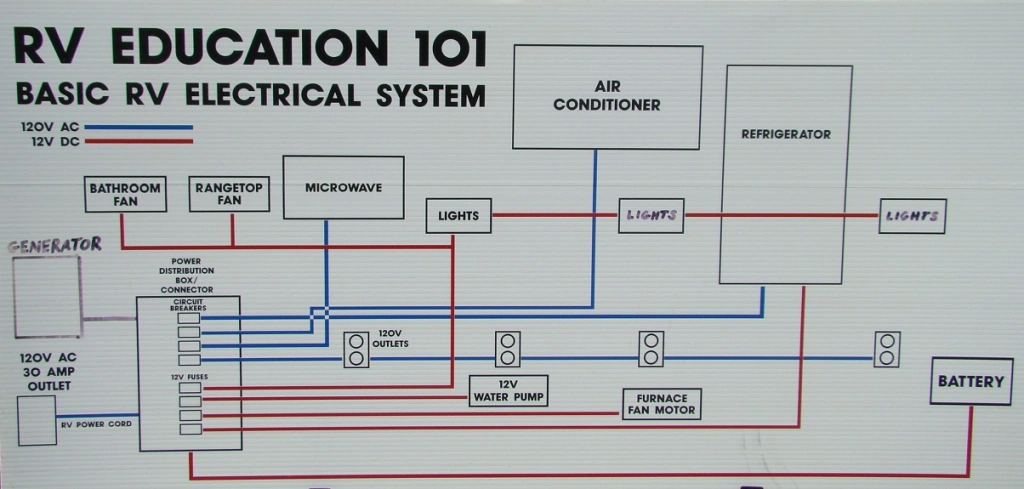
Your RV has three separate electrical systems. Some will argue there are only two, but with my background in automotive maintenance I can attest there are three. RVs have a 12-volt DC automotive system, a 12-volt DC coach system, and a 120-volt AC coach system. We are primarily concerned with the 12-volt DC coach system and the 20-volt AC coach system.
RV 101® *Note: DC is an abbreviation for Direct Current. Direct Current is electricity supplied by the RV batteries. DC electricity flows in one direction, from negative to positive. 12-volt DC electricity is stored in the RV batteries and supplies power to components that operate on 12-volt DC electricity. AC is an abbreviation for Alternating Current. Alternating Current changes direction (or alternates) sixty time every second. Power companies and AC generators produce sine wave Alternating Current (AC), which is used to operate 120-volt appliances and electronic equipment in your home and RV. I will talk more about “sine wave” in a moment.

Most campgrounds you stay at provide you with an external 120-volt electrical source to plug the RV power cord into. Your RV has a heavy-duty power cord that is roughly 20 feet long, so it can reach the campground pedestal. Depending on the type of RV you have, or purchase, it will either have a 30-amp or 50-amp electrical system.
RV 101® *Note: A 30-amp power cord has a 3-prong plug, whereas a 50-amp power cord has a 4-prong plug. Watch the video below to learn more.
Most campgrounds offer both 30 and 50-amp electrical connections. Prior to plugging the RV in, turn the circuit breaker off at the pedestal, plug the power cord in and then turn the breaker on. When you plug your RV power cord into the proper campground electrical source it will supply power to the RV’s power distribution panel and throughout your RV. You must have a 120-volt AC power source to use the microwave, roof air conditioner, the refrigerator in the AC mode, the 120-volt electrical outlets, and any other 120-volt appliances or components in the RV.
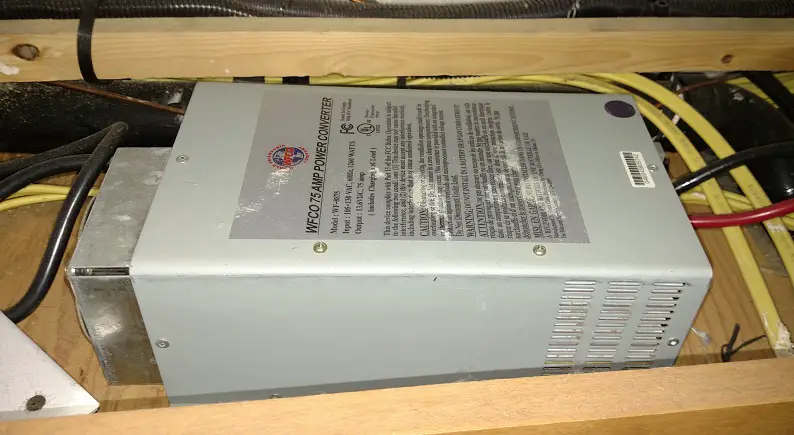
For the most part, everything else in the camper works on 12-volt DC or battery power. When you are plugged in at the campground the RV’s power converter/battery charger (above) converts part of the 120-volt AC current to 12-volt DC current to operate the items in the RV that work on 12-volts. Some typical 12-volt items are the overhead lights, the furnace fan, the range top fan, the vent fan in the bathroom, the water pump, LP gas leak detector, stereo, and the refrigerator when it is in the LP gas mode.
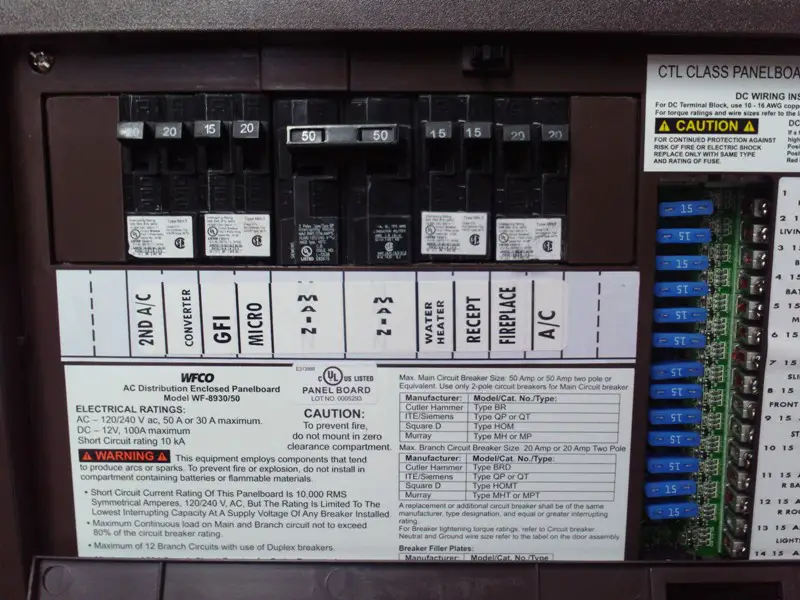
If you look at the RV’s power distribution panel you will see circuit breakers like you have in your house for the 120-volt AC side, and automotive style blade fuses for the 12-volt DC side. The circuit breakers and fuses should be labeled for easy identification.
RV 101® *Note: If a 12-volt or 120-volt item does not work when the RV is plugged in, check the power distribution panel for a tripped breaker or blown fuse.
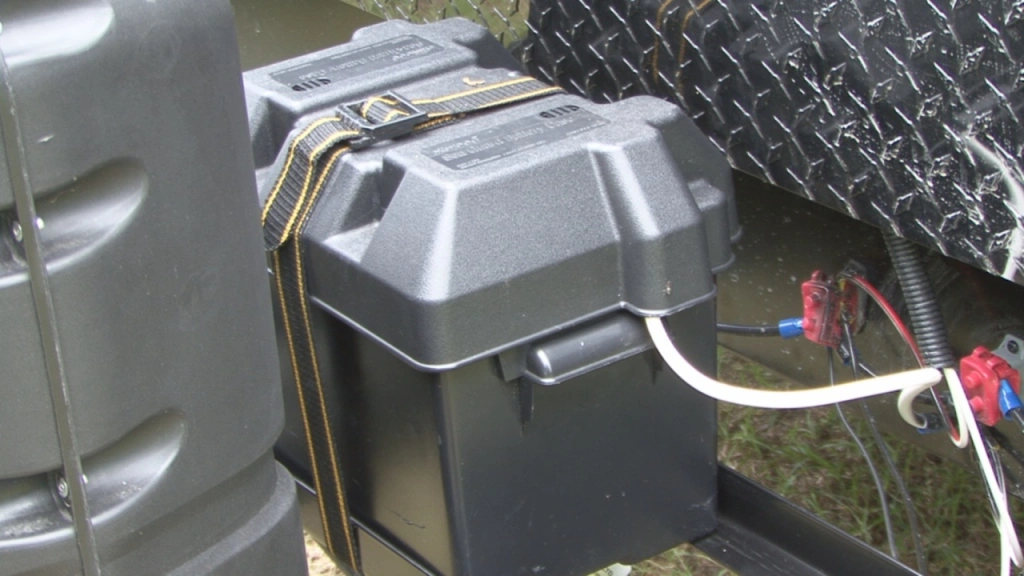
If you are not plugged into an external power source you can still use the 12-volt DC system if you have a charged 12-volt deep-cycle battery on your unit. If the battery or batteries are charged you can use everything in the RV except the microwave, roof air conditioner, the refrigerator in the AC mode and the electrical outlets. If you have a motorhome, or you are going to purchase a motorhome, it has a battery for the automotive system and an auxiliary battery (or batteries) for the coach system. The auxiliary battery is charged whenever the motorhome’s engine is running, the onboard generator is running, and when the RV is plugged into an external 120-volt electrical source.
The 12-volt battery is an integral component in the RV’s electrical system, so before going any further I would like to offer some basic battery preventive care and maintenance tips to keep your RV batteries in top operating condition.
Caution: Never work around lead-acid batteries with an open flame. Vapors from the batteries gassing can ignite, causing serious damage. Remove all jewelry and always wear gloves and eye protection when working on or around batteries. To prevent the possibility of arcing, turn off any 12-volt power sources and disconnect the main negative battery cable prior to working on or around the batteries.

RV 101® *Note: If you have a maintenance free battery, you will not be able to perform some of these checks. The color displayed in the eye on the battery will indicate the condition of a maintenance free battery. Consult your owner’s manual for more information on maintenance free batteries.
Lead-acid batteries use a mixture of sulfuric acid and distilled water. This mixture is called electrolyte. Constant charging depletes electrolyte levels in batteries. Inspect electrolyte levels and add distilled water as required. Add water until it reaches the split-level marker in each cell. Do not overfill. Watch the video below to learn more.
Inspect all battery cables and terminal connections. Keep all connections clean and tight. Do not over tighten. When battery terminals are clean and tight on the battery post spray the terminals with a battery terminal protector to prevent corrosion. To clean the battery itself use a 50-50 diluted baking soda and water solution. After cleaning, flush the battery thoroughly with water.
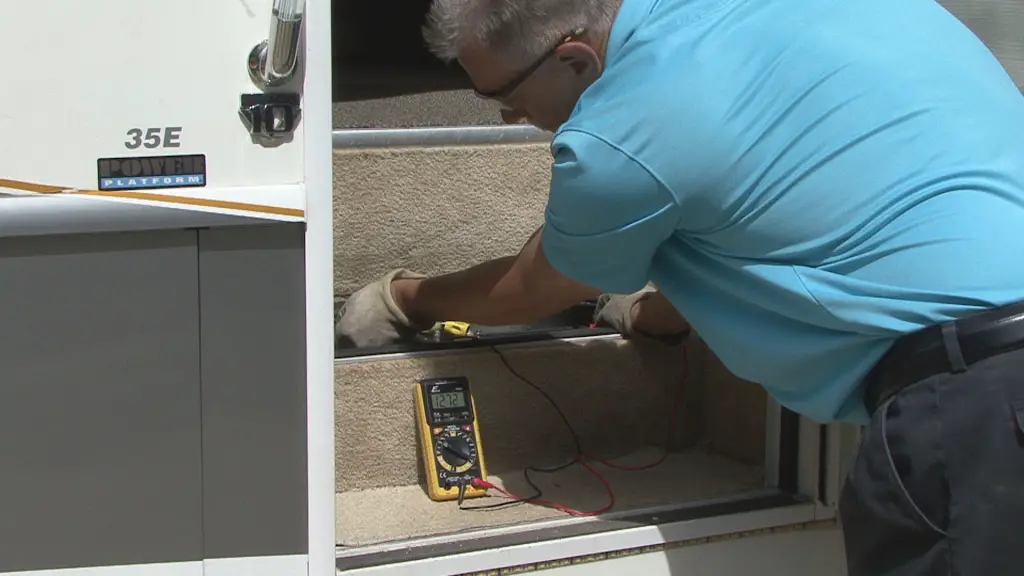
It’s important you keep the batteries fully charged. The simplest way to check the battery state of charge is using a multi-meter. If you remove the batteries for storage charge them to a full charge and check them periodically during storage. Re-charge, as necessary. Follow proper charging instructions for the type of battery. Deep cycle batteries require a lower amp charge over a longer period.
To learn more, check out my RV Battery Care & Maintenance e-book training course
There are numerous electronic devices and equipment in your RV that can drain the coach battery when you are not using the RV. Some examples are the TV antenna booster, the LP gas leak detector, clocks in radios, or leaving a 12-volt light on by accident. If your RV is not equipped with a battery disconnect switch, I recommend having one installed. When you are not using the RV or have no requirement for the coach battery you simply hit the switch and disconnect the battery. A battery disconnect can be installed on the chassis battery too.
Lastly, if you are not comfortable performing the maintenance on your RV batteries have it done by a qualified service center.
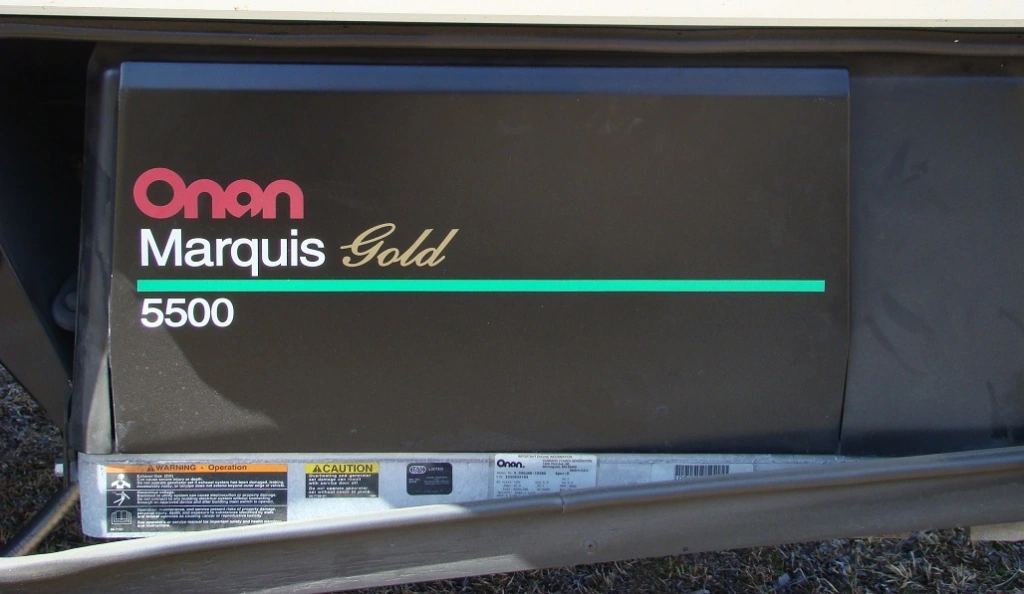
Most motorhomes and some trailers provide an additional source of 120-volt AC power with an onboard power generator. This unique feature offers the convenience of 120-volt AC power whenever you need it, making the RV fully self-contained. On motorhomes the fuel supply for the generator comes directly from the motorhome fuel tank. The system is designed so the generator stops running when the fuel gets to 1/4 tank. This prevents using all the fuel in the tank, leaving you stranded. Some motorhomes have an automatic switchover from an external power supply to the generator. Other motor homes require you to plug the motorhome power cord into a generator receptacle on the RV to use the generator.
Most RVs sold have a 30-amp electrical system, so I will use that as an example. Most campgrounds you stay at will provide a 30-amp outlet your RV power cord will plug directly into. If you go to a campground that only has a 20-amp house type outlet there are electrical adapters you can use to go from your RV plug to the house type outlet. But this limits what you can use in the RV to a maximum of 20 amps. Caution: It is possible to damage some appliances if they do not get the required amperage to start and operate properly. For example, if you plug the RV into a 15-amp outlet and you use a small appliance drawing 5-amps, there are 10-amps remaining. Then you turn the roof air conditioner on, but when the air conditioner’s compressor engages it needs 13 or more amps, and it is not available. This can damage the air conditioner’s compressor and other components.
You need to be selective about what you are using, even with a 30-amp service. If you try to use too much electricity the RV will let you know by tripping a breaker in the distribution box and hopefully no harm will be done. Watch the video below to learn more.
It is a good idea to take a small digital line monitor along with you that you can plug directly into one of the visible outlets in the RV. Campground electricity fluctuates depending on the demand placed on it. If everyone in the campground is running his or her air conditioner the voltage may drop below an acceptable level, and it would be wise to wait until it is restored back to normal.
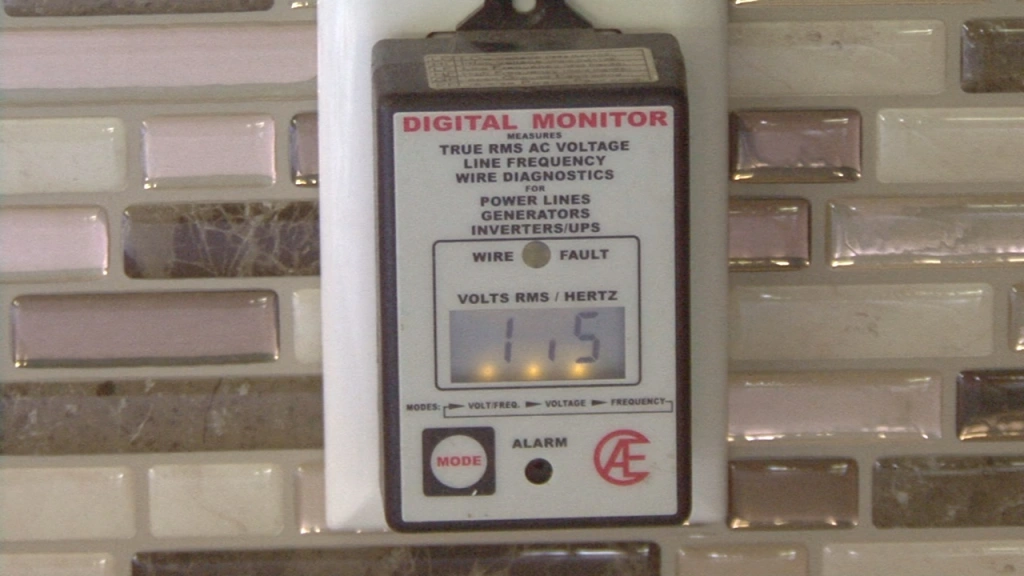
You can glance at the digital line monitor every time you walk by it and save yourself untimely and costly repairs to your RV appliances. Voltage below 105-volts or above 135-volts can damage electronic equipment and appliances.
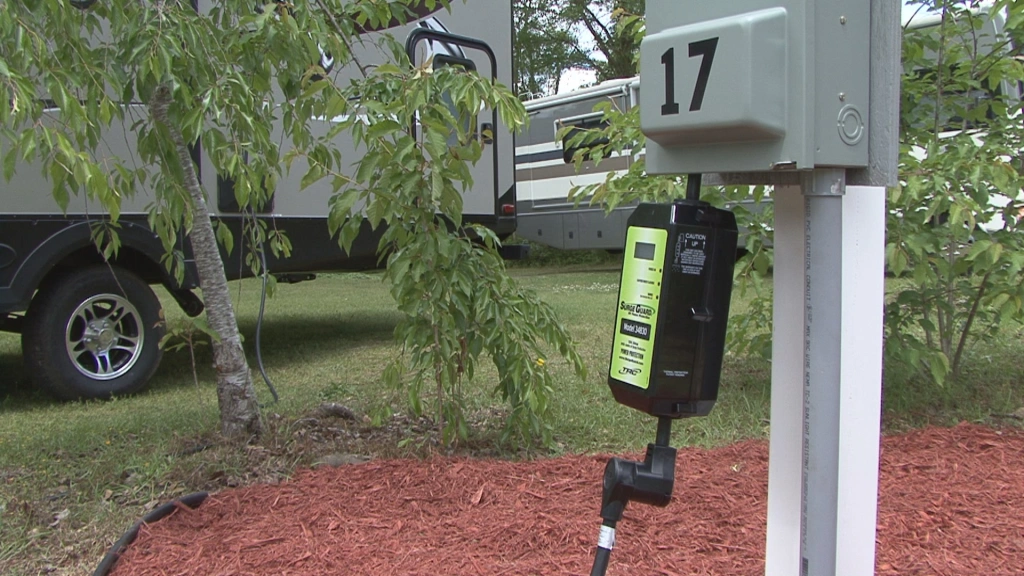
RV 101® *Note: There are in-line surge guard products you can purchase designed to shut the power off when it detects a problem with the electricity and turn it back on when power is restored. This can potentially save you money in the event of a power issue.
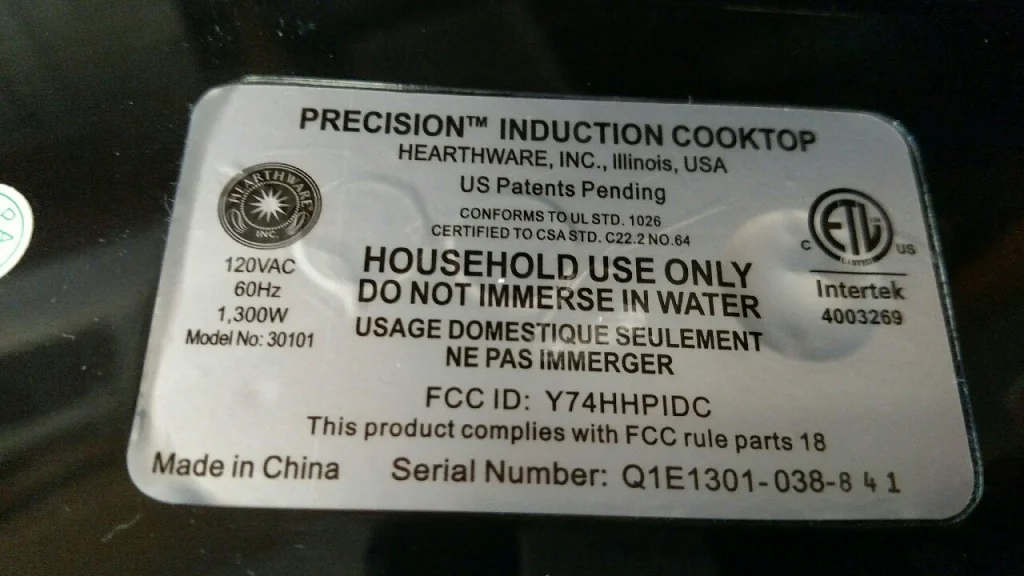
Most appliances have labels that tell you what the required wattage or amperage is to run the appliance. Here is the amperage draw for some common RV appliances and electronics.
- Coffee maker – 8.3 amps
- Converter – 8 amps
- Hair dryer – 9 to 12 amps
- Microwave – 13 amps
- Refrigerator – 2.8 amps
- Roof a/c 13.5 amps
- TV – 1.5 amps
- Toaster – 8 to 10 amps
- Electric skillet- 6 to 12 amps
Keep in mind appliances require more power to start than to run. Here are a couple helpful electrical equations:
- Watts divided by Volts = Amps
- Amps times Volts = Watts
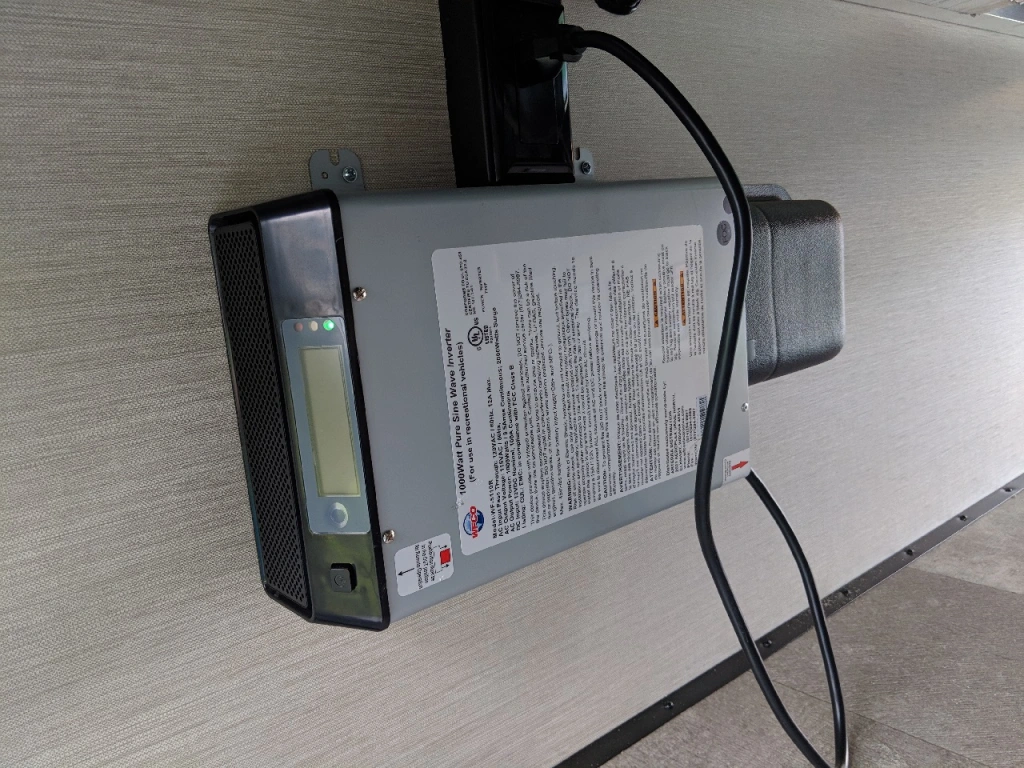
This article would not be complete without mentioning inverters. Most RV owners with experience camping have probably been in a situation where they needed an inverter at one time or another. Maybe it was when you were dry-camping and didn’t have access to electricity, or maybe you have a generator but it’s after quiet hours but you still want to watch a TV program or use the microwave. Batteries produce power in Direct Current (DC) that run at low voltages. Power companies and AC generators produce sine wave Alternating Current (AC), which is used to operate 120-volt appliances and electronic equipment. An inverter takes 12-volt DC power from your RV batteries and electronically changes it to 120-volt AC power.
You don’t want to buy a bigger inverter than you need, but you also don’t want one that’s too small for how you plan to use it. Inverters are available in small portable units that plug directly into a 12-volt power outlet; and in larger high powered, hardwired units that can provide electricity for the entire RV’s electrical system. The latter are typically permanently installed in the RV. Many of the inverters found in RVs today are inverter/chargers. What this basically means is they are inverters, battery chargers and a transfer switch all in one. They act as a battery charger when you are plugged into an electrical source, or using the generator, and they invert stored DC battery power when no electrical source or generator power is available. Many inverters are capable of transferring from inverter to battery charger automatically.
Inverters are rated in watts and come in a variety of sizes ranging from 75 to 3000 watts. The size of the inverter you need depends on several factors. If most of your camping is done at campgrounds where electricity is plentiful you may not need an inverter. On the other hand, you might enjoy boondocking where all your 120-volt requirements depend on batteries and an inverter.
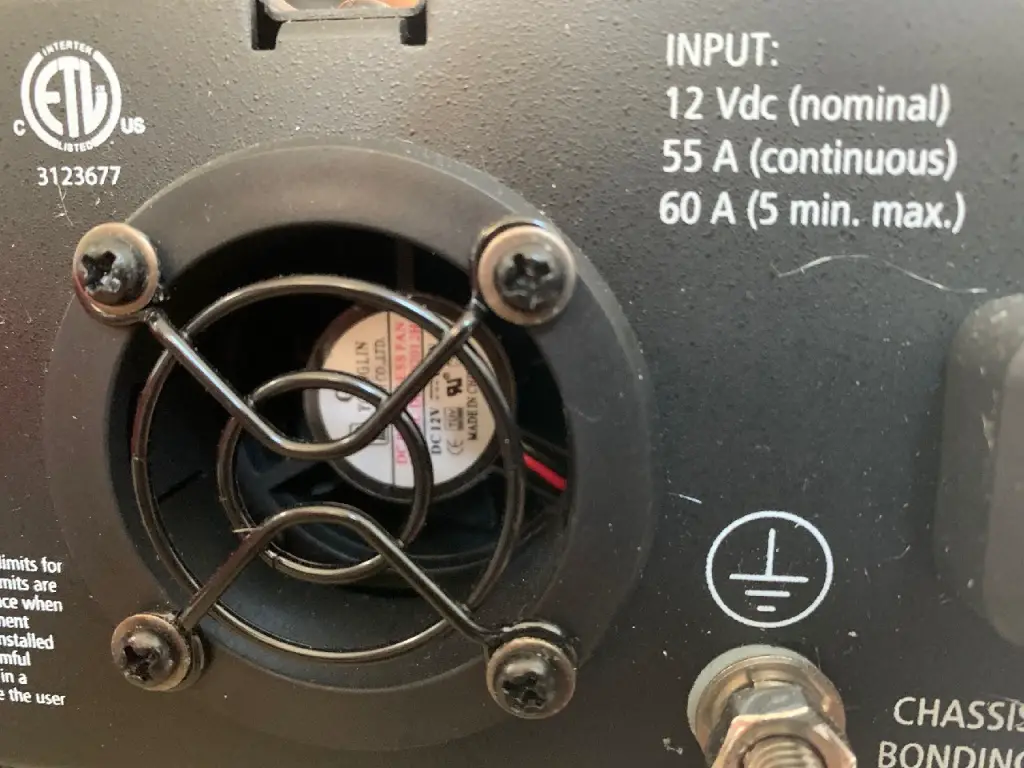
When you purchase an inverter the output capacity must be capable of operating the electrical loads placed on it. Inverters have two different capacity ratings, continuous output rating and surge capacity rating. Continuous output is the maximum wattage the inverter can output for a long period of time. Surge capacity is the maximum wattage the inverter can output during initial start-up. All appliances require more power when they initially start, as compared to what they use when they are running. Some can use as much as two or three times the amount to start that it uses to run, so the starting power required for any appliance you plan to use with the inverter must be within the surge capacity rating.
Let’s say you only plan to use an inverter to run one or two small appliances. In this case you can probably get by with a 300-watt inverter. Other RV owners use inverters to operate microwaves, coffee pots and other larger power-hungry appliances which require a larger more sophisticated inverter.
Another consideration is the type of AC power being produced. There are modified sine wave inverters and true or pure sine wave inverters. Modified sine wave inverters are less expensive and will power most types of appliances. The downside to modified sine wave inverters is that some electronic equipment will not run on this waveform, and because it’s not true or pure sine wave you may get some electrical noise or a snowy picture on your TV screen. True or pure sine wave inverters are more expensive, but they can produce power as good as a power company, and all appliances and electronic equipment will run the way they are intended to. Microwaves, motors, and other inductive loads will run quieter and will not overheat, and electrical noise will be reduced. If you plan to use a computer or other sensitive electronic equipment you may want to consider a true sine wave inverter.
Another important consideration when using an inverter is your RV battery(s). The more electricity you plan to use not only requires a larger inverter, but a larger battery bank too. Batteries are rated in amp hours. The amp hour rating is basically how many amps the battery can deliver for how many hours before the battery is discharged and needs to be recharged. Amps times hours. In other words, a battery that can deliver 5 amps for 20 hours before it is discharged would have a 100-amp hour rating.
You need to compute the amperages you plan to use and the amount of time you plan to use it to determine if your battery(s) can provide enough stored power. Keep in mind when you make your calculations that a battery discharged to 50% of its capacity is basically dead and needs to be recharged. The power, in watts, drawn from the batteries by your inverter is the same as the power, in watts, drawn by the 120-volt AC items, plus about 15% for losses in the inverter.
Finally, you need to consider that any battery power used must be put back in through some type of effective charging system. Batteries need to be charged in three stages. The first stage is a bulk charge that replaces about 80% of the battery capacity very quickly. The second stage is the absorption stage that replaces the remaining 20% and the last stage is the float stage which is a lower voltage designed to keep the battery(s) topped off, but not overcharge them.
Hopefully, this primer on RV electricity will provide you with a better basic understanding of how your RV’s electrical system works.
Happy RV Learning,
Mark J Polk
RV Education 101
http://rveducation101.com/
RV Education 101 is a leader in the industry when it comes to RV education. Our RV training is affordable and in-depth. You don’t have to be concerned if the information you are getting is correct. Your instructor is RV expert Mark Polk, who is an active RVer, with 25 plus years as an RV educator in the RV industry! Watch the RV videos, follow our original RV checklists, and read all of the RV e-books.
Learning RVs the easy way. Reputable, easy to understand, thorough, self-paced & affordable. Lifetime access. RV orientation walk throughs on how to use and maintain a motorhome, travel trailer and 5th wheel with RV Education 101® downloadable segments.
You will master your travel trailer, 5th wheel or motorhome the easy way, and quickly be on your way to enjoying your RV experiences.
Not a subscription based course. We never inundate you with emails. Founded in 1999 the leader in RV Education.
RV Online Video Training For ALL Computers and Devices:
RV Online Single Video Titles
Travel Trailer & 5th Wheel Trailer RV Orientation Video Training
Tow Your Travel Trailer Like a Pro Video Training
Tow Your 5th Wheel Like a Pro Complete Online Video Training
Motorhome RV Orientation Video Training
Drive Your Motorhome Like A Pro Complete Online Video Training
RV Essential Items Video Training
RV Care & Preventive Maintenance RV DIY® Online Video Training
Winterizing and Storing Your RV Video Training
RV Online Video Value Sets
Travel Trailer 5 Video Set Plus free RV Checklist ebook
5Th Wheel 5 Video Set plus free RV Checklist ebook
Motorhome 5 Video Set plus Free RV Checklist ebook
Travel Trailer 6 Video Set Plus free RV Checklist ebook
5Th Wheel 6 Video Set plus free RV Checklist ebook
RV 101 Motorhome Online 6 Video RV Orientation Training Bundle
RV 101® Travel Trailer Ultimate Video & E-book Bundle
RV 101® 5th Wheel Ultimate Video & E-book Bundle
RV 101® Motorhome Ultimate Video & E-book Bundle
RV Online E-Book Titles
An Introduction to RVs E-Book Training
Insider’s Guide to Buying an RV
Owning & Operating an RV E-Book Training
The Original Checklists for RVers E-Book
RV Campground Basics E-Book Training
RV Safety Features, Tips & Tricks E-book Training
RV Care & Maintenance E-Book Training
Winterizing & Storing Your RV E-Book Training Course
RV Battery Care & Maintenance E-Book Training
Trailer Towing Basics E-Book Training
Official RV 101® Guide to RV Generators
Official RV 101® Guide to RV Water Systems
Official RV 101® Guide To RV Water Heater Use & Care
Official RV 101® Guide – Trailer Towing, Weights & Safe Towing Explained
Official RV 101® Guide to Understanding Trailer Sway
RV Online E-Book Value Sets
A Collection of RV Education 101 E-Books – 9 RV E-BOOK BUNDLE SET
Official RV 101® Guides for Travel Trailer Bundled Set